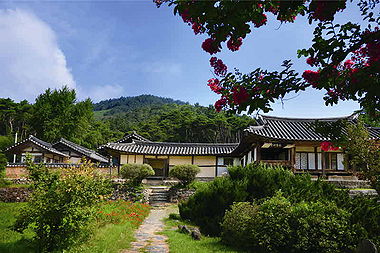논산 명재 고택(論山明齋古宅)
| 윤증 고택 | |
|---|---|

| |
| 지정 번호 | 중요민속문화재 제190호 |
| 지정일 | |
| 지정 명칭 | 논산 명재 고택(論山明齋古宅) |
| 한자 명칭 | |
| 영문 명칭 | Myeongjae Historic House, Nonsan |
| 분류 | |
| 건립·제작 | |
| 주소 | 충남 논산시 노성면 노성산성길 50 (교촌리) |
| 위도 | 36.2822276 |
| 경도 | 127.1311420 |
| 웹사이트 | |
관련 기사
윤증의 실심실학(實心實學) / 김동근
개관
조선 숙종 때의 학자인 윤증(1629∼1714)[1]이 지었다고 전하는 집이다.
후대에 수리가 있었던 듯 하며 그 세부기법은 19세기 중엽의 건축양식을 보이고 있다. 노성산성이 있는 이 산의 산자락에 노성향교와 나란히 남향으로 배치되어 있다.
높은 기단 위에 앞면 4칸·옆면 2칸 규모의 사랑채가 있고, 왼쪽 1칸 뒤로 '一' 자형의 중문간채가 자리잡고 있다.
중문간채는 안채가 바로 보이지 않도록 1칸 돌아 들어가게 중문을 내었다. 중문을 들어서면 'ㄷ'자 모양의 안채가 있어서, 중문간채와 함께 튼 'ㅁ'자 모양을 이루고 있다.
집 앞에는 넓은 바깥마당이 있고 그 앞에 인공연못을 파고 가운데에 원형의 섬을 만들어 정원을 꾸몄다. 또한 안채 뒷쪽에는 완만한 경사지를 이용하여 독특한 뒤뜰을 가꾸어, 우리나라 살림집의 아름다운 공간구조를 보이고 있다.
모든 건축부재의 마감이 치밀하면서 구조가 간결하고 보존상태도 양호한 조선의 양반주택으로 중요하다.
지정 당시 명칭은 '윤증선생고택(尹拯先生故宅)'이었으나, 조선 숙종 때의 이름난 유학자 명재 윤증(1629-1711)이 지었다고 전하는 가옥인 점을 반영하여 그의 호를 따라 '논산 명재 고택'으로 지정명칭을 변경(2007.1.29)하였다.[2]
영문 해설
Myeongjae Historic House
This house was built in the 18th century by Yun Jeung (1629-1714), a notable Confucian scholar of the late Joseon period. However, it appears to have undergone extensive reconstruction in the 19th century.
This house is called Myeongjae Historic House, after Yun's pen name, Myeongjae.[3]

Structure
Unlike most upper class hanoks, Myeongjae Historic House lacks a wall surrounding the entire complex. This results in some unique features, such as no main gate and some buildings being directly accessible from the outside. Its main buildings include a sarangchae (men's quarters) in front, anchae (women's quarters) in the middle, and shrine to the back right. It also has a jungmunganchae, with a gate to the anchae, as well as a gotganchae, used for storage, to the left of the anchae. The anchae and gotganchae are located behind a wall which can be entered by the jungmunganchae. The shrine also has its own wall. To the left of Myeongjae Historic House is Noseonghyanggyo, a local Confucian school where Yun Jeung frequented with fellow Confucian scholars.
- Sarangchae
A sarangchae is a space found in most hanoks which is used by the men of the house as a place for study and private social gatherings. This sarangchae has three main spaces: a sarangbang (study room) in the middle, a daecheong (wood-floor hall) to the right, and a numaru (elevated porch) to the left. Behind the numaru are a kitchen and small sarangbang, as well as a small enclosed porch, which are connected to the main sarangbang. The numaru, which is an unusual feature in a sarangchae, was designed to overlook the nearby Noseonghyanggyo Local Confucian School.
- Jungmunganchae
A jungmunganchae (lit. central gate quarters) is a structure which includes the gate leading to the anchae. In addition to the gate itself, it also has small rooms used as living quarters for servants and/or storage space. They are usually built in a straight line. This jungmunganchae has the gate placed slightly off center in order to block a direct view into the anchae.
- Anchae
An anchae (lit. inner quarter) is the most basic space found in all hanoks, as is serves as the living, sleeping, and cooking quarters of the home. It was traditionally forbidden for outsiders to enter, and with the men of the house spending much time in the sarangchae, it was thus considered the women’s domain. The anchae of Myeongjae Historic House features a spacious daecheong (wood-floored hall) in the center. It also has several rooms commonly found in anchae which were each used by various members of the family.
A unique feature of this house is that it has two kitchens. At the end of each wing of the house is a kitchen, with the small kitchen in the right wing used for convenience when preparing and moving food to the shrine. In addition, while there are walls surrounding the front and sides of the anchae, there is no wall in the back. To the back of the anchae there is a hill which both serves the function of a wall separating the anchae from the outside, yet also keeping a connection to nature.
- Shrine
Traditional Korean upper class homes feature a shrine which honors the ancestors of the family. Usually, the shrine is usually located within the wall surrounding the entire complex. However, in the case of Myeongjae Historic House, because there is no surrounding wall, the entrance gate to the shrine appears to be located apart from the family living space. Yet, this entrance gate actually serves to bring the buildings closer together. Usually, the shrine entrance is located in the middle of the wall, directly in front of the shrine itself, making it appear independent from the rest of the complex. But, in Myeongjae Historic House, the entrance gate is located to the left, close to the other spaces of the complex, making it not only feel closer and more connected to the rest of the house, but physically placing it closer to the rest of the house.
- Gotganchae
A gotcanchae is a storage space that also can be used as living quarters for servants. This gotganchae is located to the left of the anchae, but within the wall surrounding the anchae area.
사진 및 도면
사진
도면
답사 후기
- 답사 중/후에 느낀 것. 보완되어야 할 부분이 있으면 적어주세요!
출처
- ↑ 출처: "윤증", 한국민족문화대백과사전
- ↑ 출처: 문화재청, 문화재정보
- ↑ Most Confucian scholars had a pen name. Please Refer to "Art name" in Wikipedia, for more information.
- ↑ 출처: "윤증선생고택", 한국민족문화대백과사전